Äran class coastal Panzerkepp “battleships” (1901)
 Swedish Navy:
Swedish Navy:
HSwMS Äran, Wasa, Tapperheten, Manligheten 1901-1950
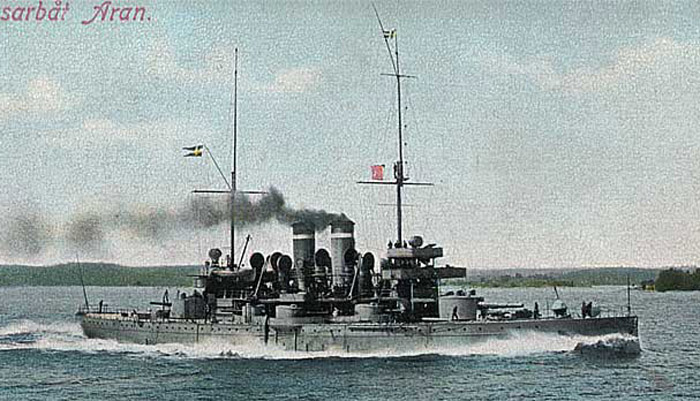
This class comprised the HSwMS Äran, Wasa, Tapperheten and Manligheten, which made the bulk of swedish coastal defensive screen in 1914. The second (HSwMS Vasa) was a famous name, recalling the rank of Sweden in international affairs in the XVIIth century. Derived from HSwMS Dristigethen, which was a prototype of some sorts, they had a fairly long career, only ending well after WW2.
Design development
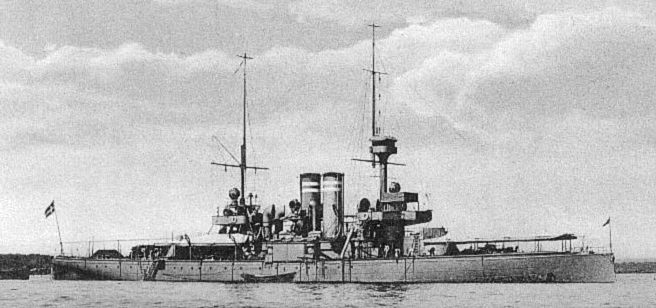
The idea behind this class was the same concerning HSwMS Dristigethen we already saw.
Precedessors: The Oden class (1897). The first, HSwMS Oden was launched at Bergsund in 1897 and followed by HSwMS Thor (same yard, 1899) and HSwMS Niord (Lindholmen 1899). They had two single Bofors 10 inches/42 guns (254 mm) and six casemates 4.7 in (120 mm) secondaries, plus ten QF 6-pdr Bofors (47 mm) to deal with TBs, plus a single 450 mm (8 in) forward underwater torpedo tube. At 3,445 tons standard, propelled by two 2 shaft drived by VTE engines rated for 5,350 ihp (16.5 knots) they also received Schenider Creusot armoured plates protection with a 9 inches (240 mm) armored belt, 8-inches (203 mm) on their turrets and 10-inches face. Harvey steel was used for Thor and Niord. These ships, completed in 1900-1901 were the second class of three ships to be built since the Svea class of 1886. They were followed by the Äran class (1901) and Sverige class (1911).
Prototype: Pansarbåt HM Dristigethen (1900)
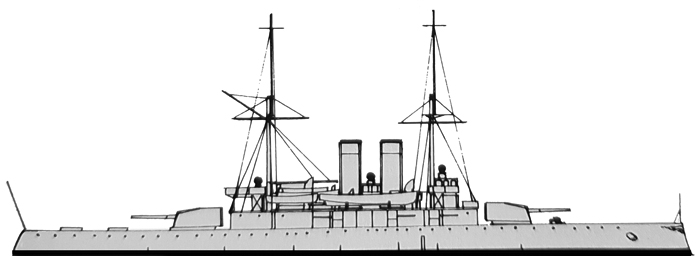
Dristigethen’s general design was very close to the Äran class (conways)
HSwMS Dristigethen was in reality the blueprint for the Äran class; This single coastal battleship was designed as a replacement for the Svea class (1886) and she was launched at Lindholmen in 1900, slightly smaller than the Äran that would follow, at 3,445 tons standard and somewhat reduced machine power at 5,400 hp for 15.5 knots in top speed. She inaugurated the new 8.3 inches (210 mm) Bofors naval guns in single turrets fore and aft that would rejuvenate the concept of “Panerkepp” and added to this six Bofors 15 cm guns arranged in barbettes and ten 6-pdr, two TTs.
Protection-wise she relied on Harvey steel, with a 8 inches belt (200 mm) and 6-8 inches for her turrets. She would serve in WW1 and was famously rebuilt in 1924 as an aircraft & repair depot ship in Bergsund, Stockholm. She had her armour and main armament removed but was rearmed during WW2, receiving four 75 mm, 2x 40 mm AA and four KSP light MGs.
Appropriations for the construction of the first of three vessels, HMS Äran (Wasa and Tapperheten were the following ones) were approved by the Riksdag in 1899. The government had not formally requested this in its bill, but plans were included in the government’s documentation from the naval administration. The reason the construction was approved among other things is that the Norwegian Navy added two new armored ships the year before and two more were under construction and this was also the result of the Swedish-Norwegian union’s crisis, these ships could become a threat to Sweden.
Following tenders from Swedish and foreign shipyards, it was decided all three would be made as well in Swedish shipyards. Lindholmen’s shipyard in Gothenburg was the first to laid down Äran, followed by Wasa at Finnboda shipyard, Stockholm, and Tapperheten at Kockums Mekaniska Verkstad in Malmö. Two years after the order of three coastal battleships, HMS Manligheten was also approved and like Tapperheten, to be built by Kockums Malmö.
Design of the Äran class
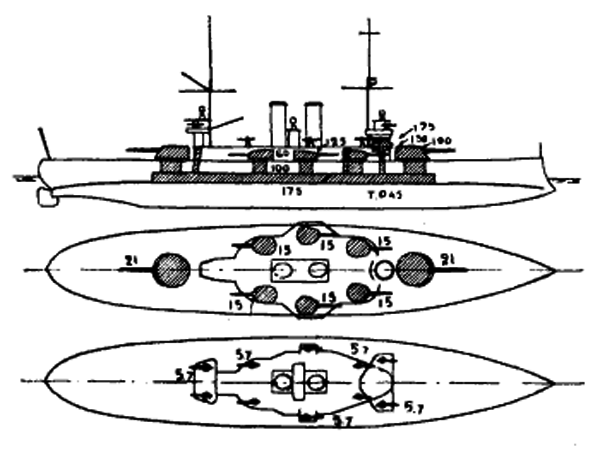
All four Panzekappen were a further development of the Dristigethen (“Bold”) and like her, they would be built of riveted steel, 89.7 meters long, 15.02 meters wide. They were longer, larger, heavier and slightly more powerful than HMS Dristigethen but slightly slower.
Armament was the ame essentually, two main 21 cm cannons fore and aft, six 15.2 cm cannons. Major difference were the latter were set up in their own turrets, instead of casemates. Light armament was similar, with six 57 mm cannons and two underwater torpedo tubes. They also carried two steam cutters among their service boats, both carrying a Bofors 37 mm w/98B for landing parties. The crew comprised 282 officers and men, more than Dristigethen (262).
Otherwise, their general appearance was close, with two tall funnels close apart and a symmetrical look with single turrets fore and aft, a central battery with the three secondary turrets and roof light QF light guns, two masts, a forward conning tower and small bridge. They looked like reduced pre-dreadnoughts.
Powerplant
Äran (“honor”) powerplant consisted in two three-cylinder triple-expansion steam engines (VTE). Machinery would consist of two 3-cylinder triple-expanding steam engines, fed from eight coal-fired steam boilers, enough for 5,500 horsepower passed on two propellers, enabling to reach 16.5 knots.
Armour scheme
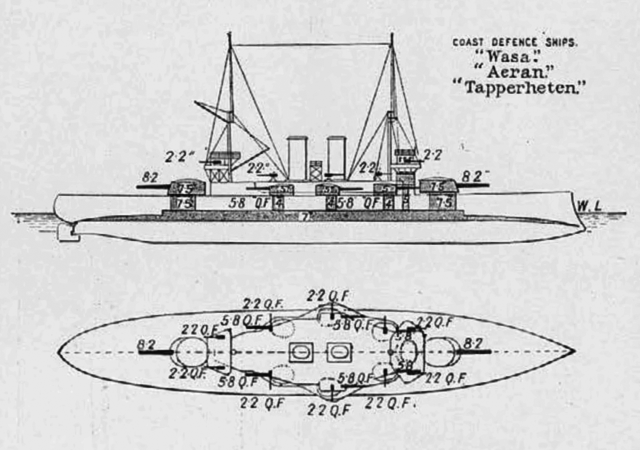
The major change compared to the previous Äran class was the side armour was taken to the upper deck for a short distance amidship. Her armour therefore was an improvement, especially when the lower decks were not forgotten either. It was made of Krupp Cemented armour.
- Turrets 7.5 inches (190.5 mm)
- Armoured Belt 7 inches (178 mm)
- Armoured deck ? circa 25 mm (1 in)
- Secondary turrets ? circa 75 mm (3 in)
Armament
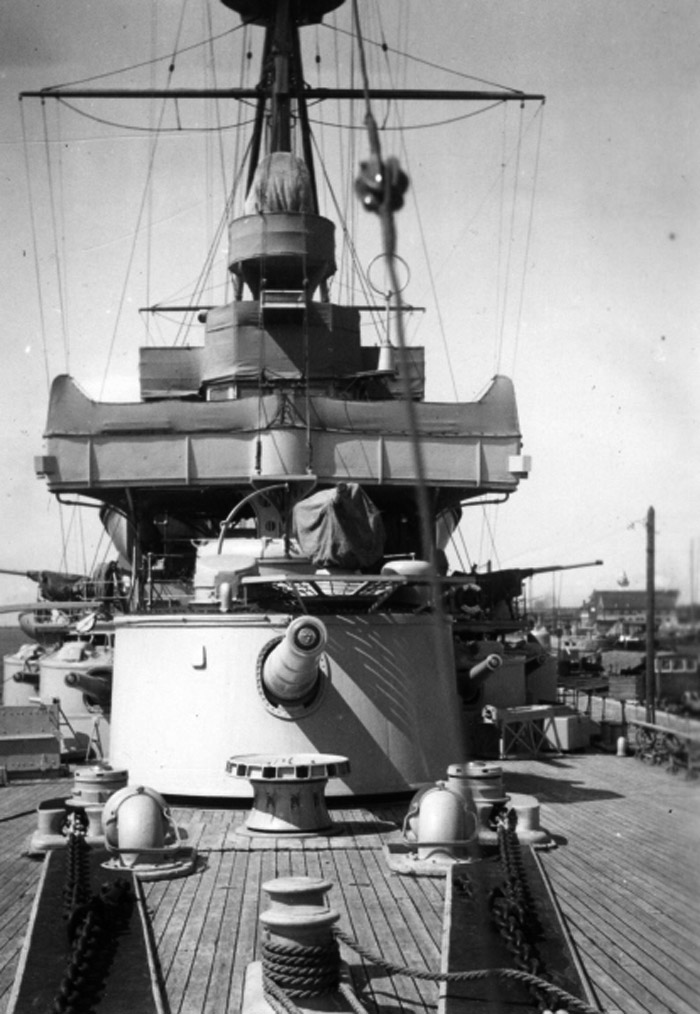
Forward gun turret of HMS Manligheten.
Main: Two turreted Bofors 21 cm K/44 M98
These 210 mm (8.3 in) models were mounted in single turrets fore and aft, centreline (axis). These models were first designed in 1898 and very similar to those used by the earlier Dristigheten. They fired a 125 kg (276 lb) shell at a 750 metres per second (2,500 ft/s). Rate of fire was two rounds a minute. The turrets were protected by Krupp cemented armor.
Secondary armament: Six 15,2 cm K/44 M98
The 152 mm (6 in) K/44 Model 1989 guns were mounted in single cradles turrets. The barrels and mounts were provided by Bofors. The turrets were placed amidship, relatively close to one another, two facing forward, one backwards.
Tertiary armament: 10x 5,7 cm, 3x 3,7 cm
These ten 57 mm/50 (2.2 in) M/89B guns were provided by Finspång. Five were placed in single mounts on either side of the bridge.
In addition, two 37 mm (1.5 in) Bofors M/98 were also placed in single mounts. but the latter could be mounted on the ship’s steam cutters for landing a parties ashore. They were also fitted with two torpedo tubes, of the standard 450 mm (18 in) caliber, both below the waterline fore and aft.
Äran class specifications |
|
| Dimensions | 87.5 x 15 x 5 m |
| Displacement | 3592 tonnes, 3900? tonnes FL |
| Crew | 285 |
| Propulsion | 2 shafts, Motala? VTE engines, 8? boilers, 6,500 shp |
| Speed | 17 knots as designed (49.3 km/h; 30.6 mph) |
| Range | 3,550 nmi () at 10 knots |
| Armament | 2 x210/44, 6x 152/44, 10x 57, 10x 57mm QF (6 pdr), 2x 450mm TTs |
| Armor | Belt 7 in, turrets 7-1/2 in, Krupp cemented and KNC armor |
Reconstructions
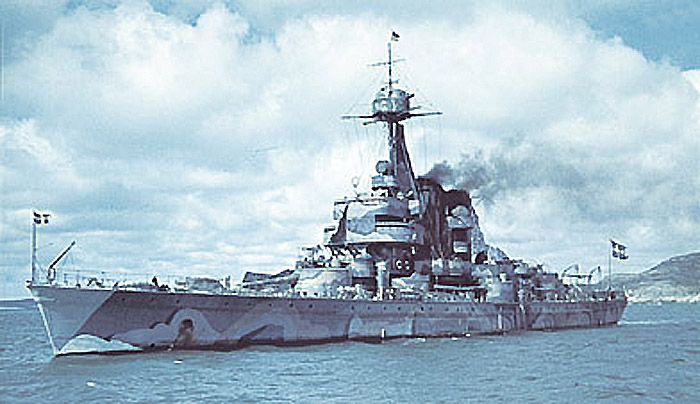
Manligheten modernized in 1943
In 1906-1910 all ships had a new tripod fore mast installed, supporting a fire control director. That was a welcome addition for the sake of accuracy, also increasing their effective range by a large margin.
The interwar reconstruction were limited. By the mid-1930s, HSwMS Manligheten had two boilers replaced by new models oil-firing. However with WW2 breaking out it seemed obvious Sweden risked to be drawn into the conflict at some point and made a massive rearmament and construction plan which also concerned the modernization of its older vessels. All four Äran class were considered for such refits programmes.
By early 1940, the first two taken in hands were Äran and Tapperheten: which were rearmed with ten 57mm/50 (6-pdr) Bofors, two 450mm torpedo tubes (18 in) and four single 57mm/50 K/55 1889B AA guns, plus two 25mm/55 K/58 M1932 Bofors.
In 1941 HSwMS Äran saw her fore superstrucure rebuilt and moved astern, while 57mm guns were moved one deck lower and two 40mm/56 K/60 M1932 Bofors and two twin 8.80 mm KPV machine guns were added to her AA defence.
In 1941 HSwMS Manligheten had her stem rebuilt with cruiser bow, her length being raised to 90.2m, her fore superstructure rebuilt and moved astern like Äran, her main guns and directors modernized, her boilers replaced by new ones oil-firing, and her main mast removed. In addition she received four 57mm/50 K/55 1889B AA gunsn four 40mm/56 K/60 M1932 Bofors and two 25mm/55 K/58 M1932 Bofors AA guns. She was the most modern of all four vessels. The last two were kept for training and parts reserve for the other two, and really never took part in neutrality patrol operations.
About the names: Swedish warships names, apart exceptions here, like Vasa, were about adjectives and values: “Honour”, “Virility” and “Bravery”. Certainly too old school to baptise ships in the 2020s with feminized crews… Modern Swedish ships nowadays are named about locations, which is far less contencious. Only the Royal Navy keeps naming ships using adjectives until recently. It seems in the context of taxpayer’s transparency naming ships about country’s communities sounds more politically acceptable. The practice was common in the USA and Germany and is now commonplace. France, Italy or Spain however rather name their ship after personalities. It seems more a “latin usage”.
Sources/Read More
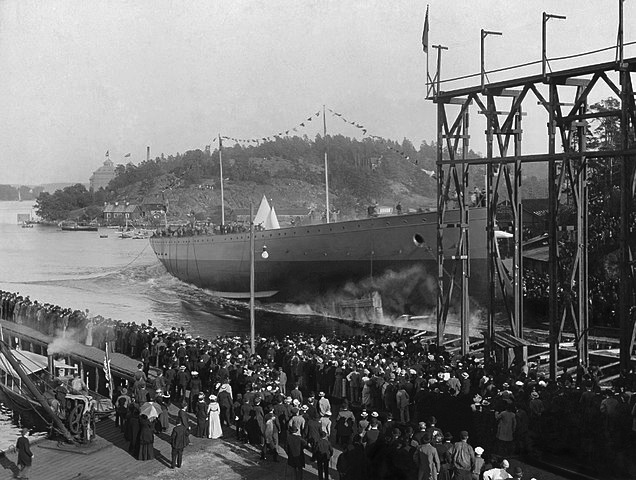
Launch of HMS Vasa
narkhammar.se
flottansman.se
Old article on runeberg.org
On navypedia.org
tugboatlars.se
worldnavalships.com
On digitalmuseum.se
wik
wik se
digitaltmuseum.org
The American marine engineer. c.1 v.11 1916.
Jane’s Fighting Ships Of World War I
Conway’s All The World’s Fighting Ships 1860-1905
Conway’s All The World’s Fighting Ships 1906-1921
Borgenstam, Curt; Insulander, Per; Åhlund, Bertil (1993), Kryssare : med svenska flottans kryssare under 75 år (1:a), Karlskrona
von Hofsten, Gustav; Waernberg, Jan (2003), Örlogsfartyg: Svenska maskindrivna fartyg under tretungad flagg (1:a), Karlskrona
Holmquist, Åke (1972), Flottans beredskap 1938-1940, Uddevalla: Bohusläningens AB
Insulander, Per; Ohlsson, Curt S (2001) (1:a), Falkenberg: C B Marinlitteratur AB
Lagvall, Bertil (1991), Flottans Neutralitetsvakt 1939-1945, Karlskrona
Insulander, Per; Ohlsson, Curt S (2001) (1:a), Falkenberg: C B Marinlitteratur AB
von Hofsten, Gustav; Waernberg, Jan (2003), Örlogsfartyg: Svenska maskindrivna fartyg under tretungad flagg (1:a), Karlskrona: Svenskt Militärhistoriskt Bibliotek
Lindsjö, Ronny (1993). Marinhistoria. Chefen för marinen.
Äran
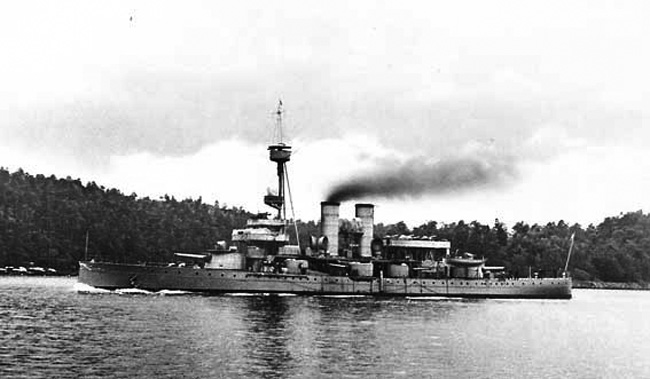
Coastal defence ship Äran
HSwMS (“Hans/Hennes Majestäts Skepp”) Äran (“honour”) was commissioned on 7 September 1902, joining the defence fleet, affected to Stockholm Naval Base. She participated in a navy parade in 1907 and participated in neutrility patrols in WWI. Nothing much happened until 1933 when she was updated, having a new telemeter. But nothing was done to her powerplant nor armament. At the outbreak of the second world war, she was prepared for service and a commissiond assessed her readiness and general state. They concluded the hull and machinery turned out to be in relatively good condition, but the artillery had major shortcomings due to the age of conception. The anti-aircraft artillery in particular was quickly pointed out as hopelessely out of date and very weak while the rest of the artillery was very short range. She was proven unable to hit anything beyond 9,000m in the best conditions, and it was reduced by night to a mere 2,500 meters.
This, combined with the fact her maximum speed, when forced, was still 16 knots, meant she was an easy prey for any modern destroyer from the German or Soviet navy in the Baltic Sea at the time. In the autumn of 1939, test firings were carried out with the heavy and secondary batteries, but apparently such damage was done to the hull structure that life firing has to be suspended for six months before being attempted again.
Äran carried out a few neutrality patrols but stayed in port for most of the war, but in 1940 she was partially rebuilt and her AA armment was improved (see reconstructions above). In 1945, she was inactive, and kept tht way until formally decommissioned in 1947. But the hull general condition was such she was still used as habour service vessel, depot ship, for the early cold war. She was sold for BU in 1961 but only towed for it in 1968, and she sank while under tow. An old lady that refused after all these years anything less than a properly watery grave… as honour commands.
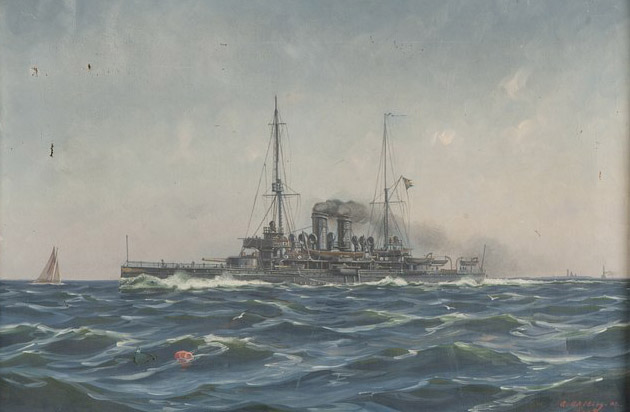
Pansarskepp_aran_history_museum
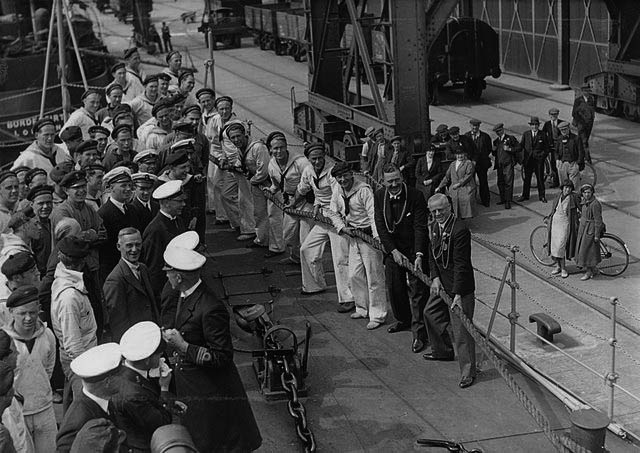
Swedish_warship_at_Newcastle_Quay
Wasa
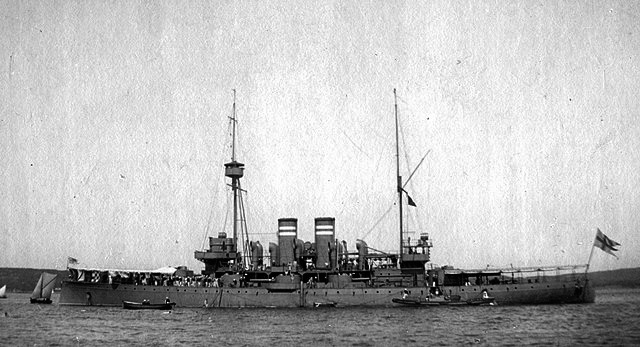
Vasa in 1901
On October 12, 1899, a contract was signed with Bergsunds Mekaniska Verkstad for the delivery of Wasa (Originaly Vasa was a famous admiral ship built by King Gustav Adolfus, the “lion of the north”). It was agreed it was to be delivered within 26 months. Her keel was laid down at Finnboda shipyard and she was launched on May 29, 1901. During her sea trials she reached a top speed of 16.77 knots. After being fully oufitted, she was commissioned on November 6, 1902. She participated in reular parades and trained with Äran in the same division, waitng for the other two to join the unit. Exercises for defensive tactics were made in coordination with torpedo boats and minelayers but also coastal fortifications, and she made a cruiser in the baltic, visiting many ports until WWI broke out. By then she asssited the fleet making neutrality patrols for the duration of the conflict.
After 1924, a commission evaluated the ship’s general condition and economic peacetime measures, and she was decommissioned and stripped of her armament. She was not formally scrapped however, until 1940, when reconverted as a mock target for enemy air reconnaissance as a deception measure. On November 9, 1960, she was sold for scrap, to the naval workshops in Karlskrona for 182,000 crowns, and scrapped in 1961.
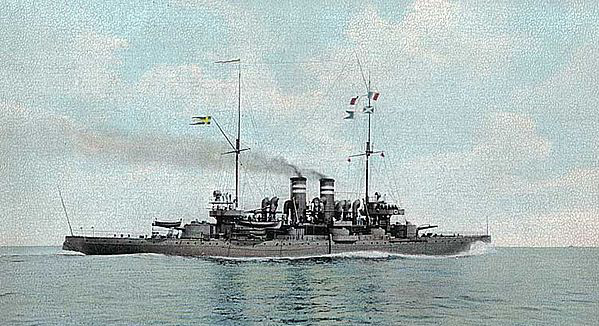
Colorized photo of Vasa in 1901, as commissioned
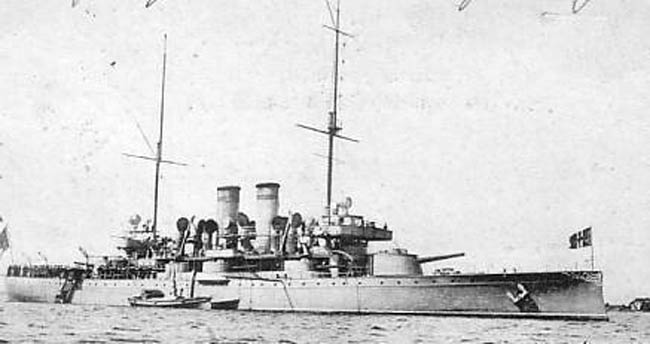
Vasa in 1903
Tapperheten
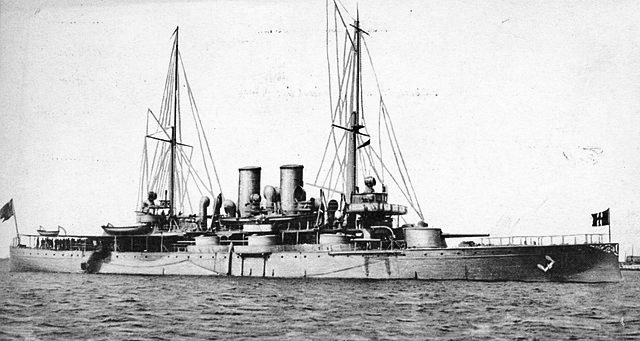
Tapperheten in 1901 as completed
On 12 November, HMS Tapperheten’s (“Bravery”) construction was ordered at Kockums Mekaniska Verkstad, with an agreed delivery to the navy within 26 months. Launched on November 7, 1901, Tapperheten was fitted out and completed, making her first sea trials, showing she wes capable of reaching 17.7 knots with force heating. However some defects were revealed which needed fixes, notably when making her first life fire trials. Two years later, she was properly commissioned. Aprt taking part in parades and training with the other two vessels of her division, and with TBs and coastal defence, it is not known if she made a cruise before the war.
On January 28, 1914, Tapperheten ran on Stålbådan rocky shoals off Sandhamn and, despite several rescue attempts, she could not be pulled away. She therefore remained on the reef for almost six months, before a new attempt finally managed to free her. Long repairs followed, in which some modernizations were carried out. In October 1914 she was able to join the coastal fleet. At the outbreak of the second world war, Tapperheten lacked any significant modernization since 12 years, but nevertheless she served as a flagship for the Karlskrona department in 1939–40. Fortunately given the international context it was decided to have her modernized in an extensive way. She was rearmed with ten 57mm/50 (6-pdr) Bofors, her four single 57mm/50 K/55 1889B converted on AA mounts, and she receive din addition two 25mm/55 K/58 M1932 Bofors. In 1943–44, she was attached to the Stockholm Squadron and patrolled Swedish waters until returneding to Karlskrona in 1945. After limited service she was stricken from the navy list on 13 June 1947, and sold in 1952 to AB Väring, scrapped in Oxelösund that year.
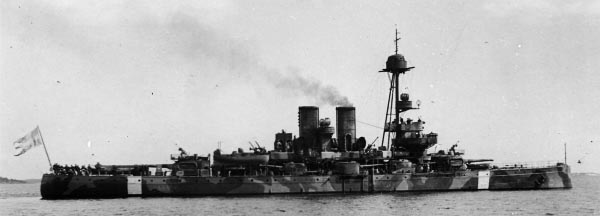
Tapperheten in ww2
Manligheten
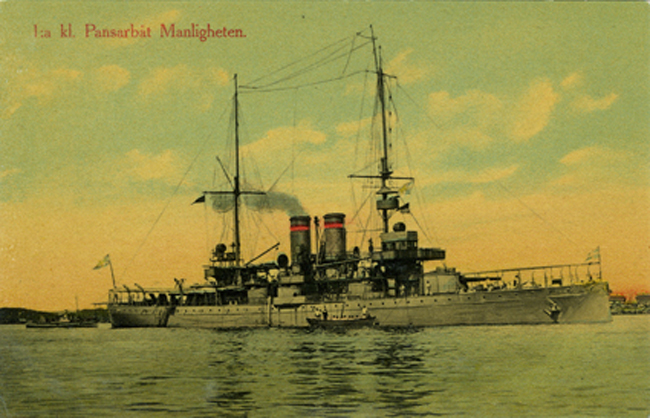
Postcard depicting the ship as commissioned in Dec. 1904
Manligheten (“masculinity/virility”) was the last of the four Äran class armoured coastal defence ships (Panzerkepp) and she was only ordered two years after the other three. This delay also played a part in fixing issues detected on the others (which hald long completion phases). This also played a part in the fact she ws the most comprehensively rebuilt and modernized afterwards. She was was built at Kockum’s mechanical workshop in Malmö, just after Tapperheten. She was eventually commissioned on 3 december 1904, one year after lauch, the fastest to be so completed. In 1906, however after live firing tests showed her actual range and accuracy, she was taken in hands to be rebuilt. To extend her practical fring range it was decided to give her a proper, modern rangefinder, and to be able to carry its weight engineers gave her a forward main mast two new legs, making it a tripod. The spotting top was rebuilt and extended to support of the telemeter and add binoculars and communication gear. This served as the blueprint to convert the other three in 1910.

HMS Manligheten original appearance in 1904
During the Kalmar union crisis of 1905, HMS Manligheten and her sister ships were part of the 1st Panzerkepp Division, part of the fleet mobilized to the west coast under command of Rear Admiral Wilhelm Dyrsen. In the mid-1920s, two boilers were modernized, fitted with a sutem allowing them to use oil instead of coal. This oil was extracted in Kinnekulle and she was one of the first Swedish warships to try it. The rest of the boilers still burnt coal as a safety measure. In 1926, Manligheten cruised abroad with HMS Tapperheten, showing the flag during many port goodwill visits. The journey started with a visit to Amsterdam, follwoed by Portsmouth, Guernsey, Vlaardingen and back to Sweden. Another trip with Tapperheten was made in 1927, this time after Plymouth going to San Sebastián and Bilbao in the bay of biscaye and back to Rotterdam and Sweden.
On August 24, 1930, Manligheten was underway off Stockholm, bound to Horsfjärden when visibility quickly deteriorated to the point it was unsafe to navigate with but at very low speed with all lookouts on deck. At 4PM, as the captain feared, she ran aground. There was no leak in the hull fortunately, but she could not free herself. The minesweeper HMS Clas Fleming nearby was called for help and tried to pull her off but she just like the output to do so. Barges with cranes were later requisitioned to unload heavy equipment and the next day HMS Queen Victoria tried to pull free, but this attempt ended quickly as the chain broke. The armored ship needed to be further lightened and it was decided to unload 225 tons of coal and all excess water for the steam boilers. After two days, HMS Queen Victoria made another attempt, without success. Before a third attempt, HMS Wachtmeister and its 24 knots would attempt by her waves to move Manligheten enough to extract herself. This succeeded and Queen Victoria could tow her off for good. She was repaired and returned into service at the end of the year.
In 1937, HMS Manligheten made a long trip abroad with cadet onboard, to Amsterdam, then Newcastle, Rouen, Cardiff, Oban, Trondheim, Klaipėda and back to Sweden. After this she remained in port for two years. When the war broke out, a commission inspected her general state like the other two ships of the Äran class. They estimated her hull and powerplant were in good conditions, bu that her armament and fire control systems needed an urgent upgrade.

HMS Manligheten in WW2, circa 1940
She was take in hands and drydocked from August 26, 1939. First off it was decided that her 21 cm main guns range of 11,000 meters and 9,000 meters for her secondary guns was unsufficient. German light cruisers of the time for example outrange her with ease at 20,000 meters. And their 15 cm guns were way faster and more accurate. Despite having a telemeter and spotting top, HMS Manligheten lacked a truly modern artillery fire control with ballistic computing, limiting her usefulness. At the started of September 1939, her equipment was modernized enough that she was reassigned to the Gothenburg Squadron as flagship.
On December 13, 1939, six men were killed and 14 injured when she was in the Gothenburg archipelago, salvaging a German paravane entangled wire, which explosives detonated. In connection with information about German naval moves prior to Operation Weserübung, HMS Manligheten departed in the afternoon of April 8, 1940 to take position for a neutrality patrol from Gothenburg to Kalvsund, the latter becoming the new forward operational base for the Gothenburg Squadron.
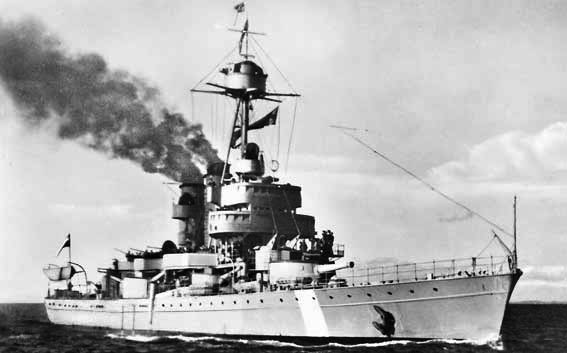
HMS Manligheten after her second refit in 1942, not yet camouflaged.
In 1941, as the most modern of Swedish warships, it was decided she was worth the expense of a full reconstruction shiwh started at Götaverken in Gothenburg. Her bridge and forward superstructure were extended and rebuilt. Her hull received a clipper bow giving her much better seagoing qualities. Her main artillery was changed by using spares previously installed on HMS Queen Victoria, and the mount elevation was modernized, giving her 21 cm main guns a higher angle, combined with rifled tubes for better accuracy and new, more powerful ammunitions. The rest of the equipment was also modernized: The original 57 mm guns were replaced by modern Bofors anti-aircraft guns. The old steam boilers were replaced by six brand new coal-fired and two oil-fired boilers. This process was over probably in early 1942 and she resumed her neutrality patrols, with the usual four-tone green-dray camouflage and white neutrality bands.
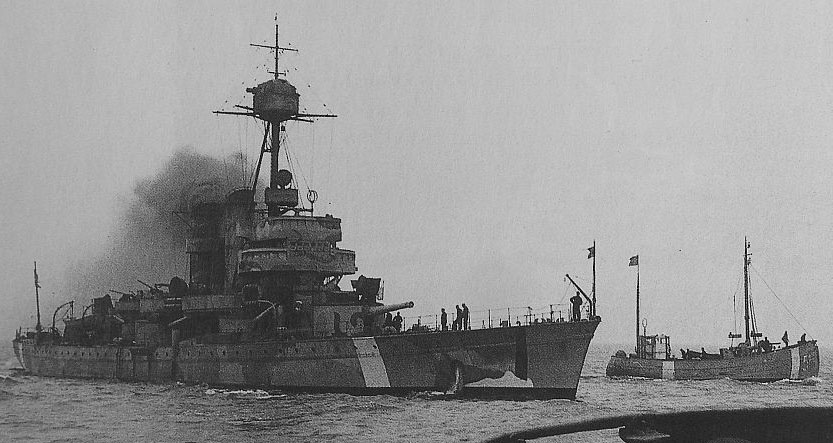
HMS Manligheten searching for the mine struck submarine HMS Ulven with an ASW trawler in 1943
HMS Manligheten was used as an harbour TS for cadets after 1945 and eventually discarded in 24 February 1950, sold in 1952 for scrapp in Karlskrona. But instead she was kept as a pontoon barge between 1956 and 1984, in the Gullmars base, Lysekil. As her name was abbreviated “MA” she was nicknamed “Emma”. During the Cold War it was also planned to use her as military barge, and until 2015, she was used as a quay for Switzer’s (formerly Röda Bolaget) tugs at Lahälla in Brofjorden. In the autumn she was towed to Fredrikshavn, Denmark for scrapping. The hull was in poor condition, but she reached her destination.


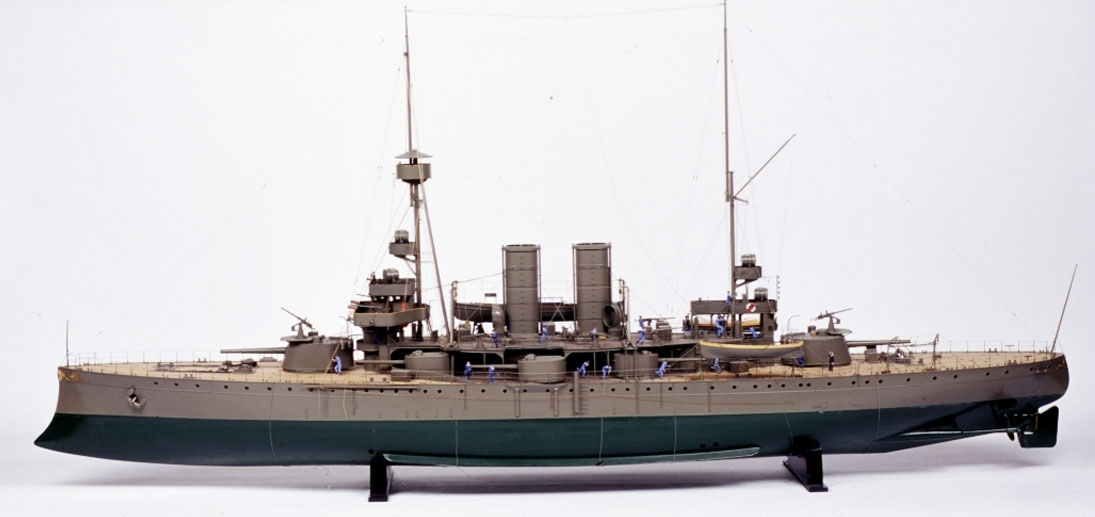
 Latest Facebook Entry -
Latest Facebook Entry -  X(Tweeter) Naval Encyclopedia's deck archive
X(Tweeter) Naval Encyclopedia's deck archive Instagram (@navalencyc)
Instagram (@navalencyc)





 French Navy
French Navy Royal Navy
Royal Navy Russian Navy
Russian Navy Armada Espanola
Armada Espanola Austrian Navy
Austrian Navy K.u.K. Kriegsmarine
K.u.K. Kriegsmarine Dansk Marine
Dansk Marine Nautiko Hellenon
Nautiko Hellenon Koninklije Marine 1870
Koninklije Marine 1870 Marinha do Brasil
Marinha do Brasil Osmanlı Donanması
Osmanlı Donanması Marina Do Peru
Marina Do Peru Marinha do Portugal
Marinha do Portugal Regia Marina 1870
Regia Marina 1870 Nihhon Kaigun 1870
Nihhon Kaigun 1870 Preußische Marine 1870
Preußische Marine 1870 Russkiy Flot 1870
Russkiy Flot 1870 Svenska marinen
Svenska marinen Søværnet
Søværnet Union Navy
Union Navy Confederate Navy
Confederate Navy Armada de Argentina
Armada de Argentina Imperial Chinese Navy
Imperial Chinese Navy Marinha do Portugal
Marinha do Portugal Mexico
Mexico Kaiserliche Marine
Kaiserliche Marine 1898 US Navy
1898 US Navy Sovietskiy Flot
Sovietskiy Flot Royal Canadian Navy
Royal Canadian Navy Royal Australian Navy
Royal Australian Navy RNZN Fleet
RNZN Fleet Chinese Navy 1937
Chinese Navy 1937 Kriegsmarine
Kriegsmarine Chilean Navy
Chilean Navy Danish Navy
Danish Navy Finnish Navy
Finnish Navy Hellenic Navy
Hellenic Navy Polish Navy
Polish Navy Romanian Navy
Romanian Navy Turkish Navy
Turkish Navy Royal Yugoslav Navy
Royal Yugoslav Navy Royal Thai Navy
Royal Thai Navy Minor Navies
Minor Navies Albania
Albania Austria
Austria Belgium
Belgium Columbia
Columbia Costa Rica
Costa Rica Cuba
Cuba Czechoslovakia
Czechoslovakia Dominican Republic
Dominican Republic Haiti
Haiti Hungary
Hungary Honduras
Honduras Estonia
Estonia Iceland
Iceland Eire
Eire Equador
Equador Iran
Iran Iraq
Iraq Latvia
Latvia Liberia
Liberia Lithuania
Lithuania Mandchukuo
Mandchukuo Morocco
Morocco Nicaragua
Nicaragua Persia
Persia San Salvador
San Salvador Sarawak
Sarawak Uruguay
Uruguay Venezuela
Venezuela Zanzibar
Zanzibar Warsaw Pact Navies
Warsaw Pact Navies Bulgaria
Bulgaria Hungary
Hungary

 Bundesmarine
Bundesmarine Dutch Navy
Dutch Navy Hellenic Navy
Hellenic Navy Marina Militare
Marina Militare Yugoslav Navy
Yugoslav Navy Chinese Navy
Chinese Navy Indian Navy
Indian Navy Indonesian Navy
Indonesian Navy JMSDF
JMSDF North Korean Navy
North Korean Navy Pakistani Navy
Pakistani Navy Philippines Navy
Philippines Navy ROKN
ROKN Rep. of Singapore Navy
Rep. of Singapore Navy Taiwanese Navy
Taiwanese Navy IDF Navy
IDF Navy Saudi Navy
Saudi Navy Royal New Zealand Navy
Royal New Zealand Navy Egyptian Navy
Egyptian Navy South African Navy
South African Navy






























 Ukrainian Navy
Ukrainian Navy dbodesign
dbodesign